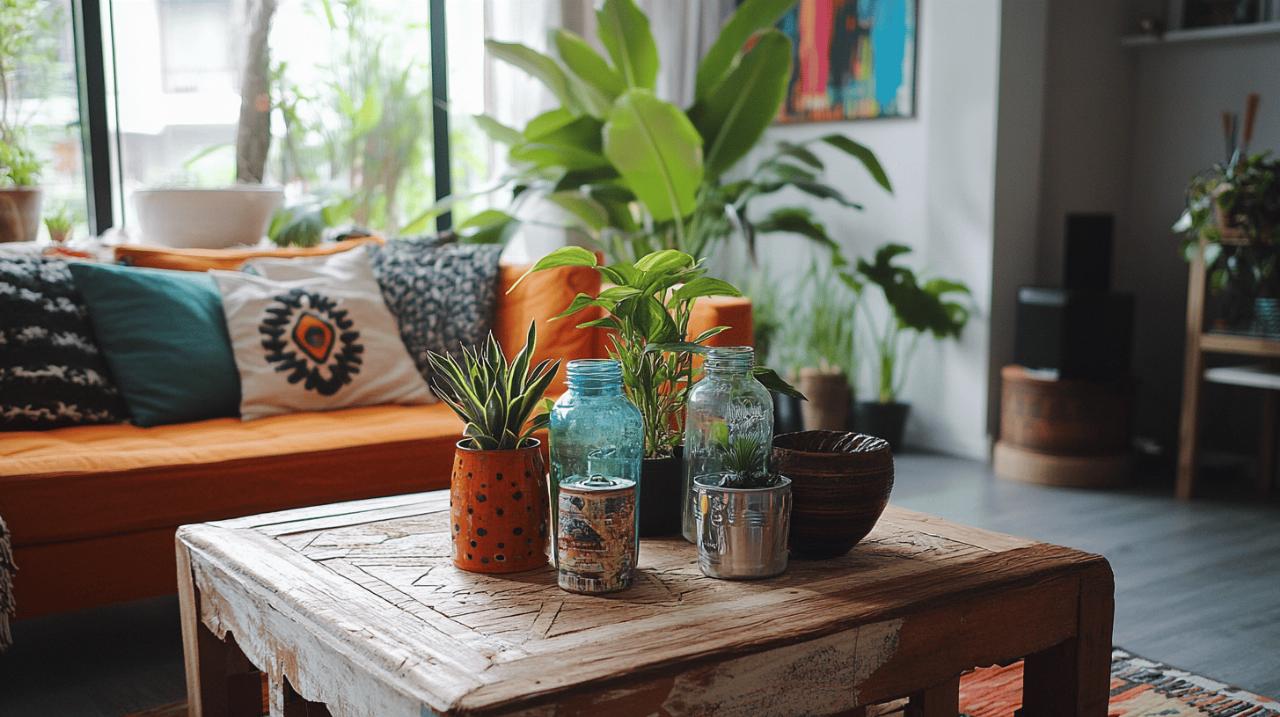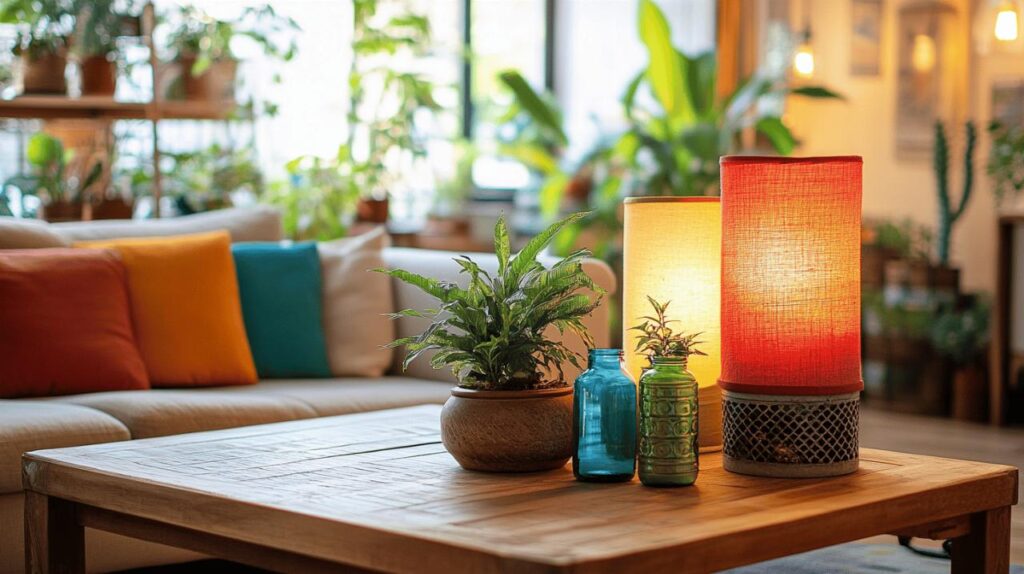In today's world where sustainability meets creativity, transforming everyday discarded items into beautiful home decorations has become more than just a trend—it's a lifestyle choice that benefits both your wallet and the environment. These innovative approaches to home decor not only reduce waste but also add unique, personal touches to your living spaces. Let's explore how you can breathe new life into objects that would otherwise end up in landfills while creating stunning decorative pieces for your home.
Transforming glass containers into home decor
Glass containers are perhaps the most versatile recycled materials for home decoration projects. According to design experts at Casa Jedo, repurposing glass items can reduce household waste by up to 12% while adding elegant touches to your interior spaces. The transparency and durability of glass make it an ideal medium for creative expression in home decor.
Painted jar vases and candle holders
Mason jars, food jars, and other glass containers can be transformed into beautiful vases and candle holders with minimal effort and expense. Start by thoroughly cleaning the containers and removing all labels. You can then apply glass paint in patterns or solid colors, or use rope, twine, or lace to wrap around the exterior for a rustic or bohemian look. For a frosted effect, apply a mixture of white glue and water before adding Epsom salt or sea salt to create a textured, crystalline finish that catches light beautifully.
Wine bottle lighting fixtures
Empty wine bottles can become stunning lighting fixtures that add character to any room. Using a glass cutting kit, you can transform bottles into pendant lights by removing the bottom and threading electrical cords through the neck. Alternatively, string lights inserted into intact bottles create ambient lighting perfect for dining areas or patios. The colored glass of wine bottles produces a warm, filtered light that creates an inviting atmosphere for gatherings or quiet evenings at home.
Wooden pallet projects for every room
Wooden pallets represent one of the most accessible and versatile recycled materials for home decor projects. These industrial cast-offs can be dismantled and repurposed into various furniture pieces and decorative elements. The natural wood grain and rustic appearance add warmth and character to contemporary living spaces.
Rustic wall shelving systems
Creating wall shelving from pallet wood involves minimal woodworking skills yet yields impressive results. After disassembling and sanding the pallets to remove splinters and rough edges, the wood planks can be arranged in various configurations to create custom shelving units. These shelves work particularly well in living rooms for displaying books and decorative items, or in kitchens for storing spices and cooking supplies. The natural variations in the wood grain create visual interest that manufactured shelving often lacks.
Pallet furniture basics for beginners
Even novice DIY enthusiasts can create functional furniture from wooden pallets. A simple coffee table requires just one or two pallets stacked together, with optional wheels attached for mobility. For outdoor spaces, pallet benches and loungers require minimal construction and can be customized with cushions made from repurposed fabric. The key to successful pallet furniture lies in proper preparation—thorough cleaning, sanding, and sealing the wood protects against splinters and extends the life of your creations.
Paper and cardboard upcycling techniques
Paper and cardboard items frequently end up in recycling bins, but with some creativity, these materials can become stunning decorative elements. From magazines to shipping boxes, paper products offer endless possibilities for eco-friendly home decor.
Magazine page wall art mosaics
Colorful magazine pages can be transformed into eye-catching wall art through various folding and rolling techniques. By cutting pages into strips and rolling them into tight coils, you can create textural mosaics that resemble paintings from a distance. Arranging these coils in patterns or abstract designs creates dimensional wall art that costs nothing but time. The glossy finish of magazine pages adds reflective qualities that change with the lighting throughout the day.
Sculptural cardboard lamps and decorations
Cardboard boxes can be cut and assembled into remarkable sculptural lighting fixtures. Using templates available online, you can create geometric lampshades that cast fascinating shadow patterns when illuminated. The thickness of the cardboard determines the sturdiness of the final product, with shipping boxes typically providing the ideal weight. These projects require precision cutting but reward patience with truly unique lighting solutions that often become conversation pieces.
Metal can makeovers
Metal cans from food products represent another category of household waste easily transformed into decorative items. Their cylindrical shape and metallic surface provide excellent foundations for various creative projects.
Tin can planters and garden displays
Food cans make perfect containers for small plants and herbs after proper preparation. After removing labels and thoroughly washing the cans, you can paint them in coordinating colors or patterns to create cohesive displays. Drilling drainage holes in the bottom ensures plants remain healthy. Arranging these can planters on windowsills, shelves, or hanging them on walls with specially designed hooks creates vibrant living displays. For outdoor use, coating painted cans with weather-resistant sealant prevents rusting and extends their useful life.
Industrial-style storage solutions
Larger metal cans can become stylish storage containers for household items. Coffee cans, paint cans, and even popcorn tins can be cleaned, painted, and labeled to create organized storage systems with industrial appeal. Attaching wooden handles or leather straps elevates their appearance and functionality. Grouping these containers on open shelving creates a cohesive storage system that combines practicality with distinctive style.
Fabric scrap decorations
Textile waste represents another opportunity for creative recycling in home decor. Old clothing, leftover fabric from sewing projects, and worn linens can all find new life as decorative elements throughout your home.
No-sew wall hangings and tapestries
Creating textile wall art requires no sewing skills when using techniques like fabric wrapping and knotting. By wrapping fabric strips around a wooden dowel or branch and knotting them in patterns, you can create bohemian-inspired wall hangings that add texture and color to any room. Combining fabrics of different textures—cotton, linen, denim—creates visual and tactile interest. These textile art pieces soften the acoustics of rooms while adding warmth and personality to plain walls.
Braided rug techniques using old clothing
Transforming old t-shirts and other clothing items into braided rugs represents one of the most practical fabric recycling projects. By cutting fabric into strips and braiding them together, then coiling and securing the braids with strong thread, you create durable floor coverings with personal significance. These rugs work particularly well in bathrooms and kitchens, where their machine-washable nature proves practical. The sentimental value of incorporating beloved but worn-out garments adds emotional resonance to these functional decor items.

